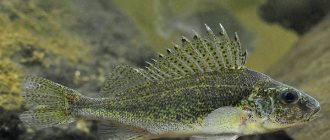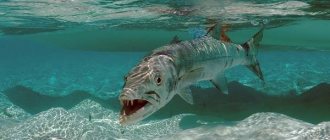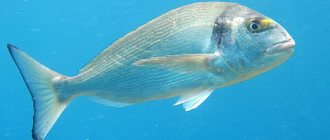- Wild animals
- >>
- Fish
The sea devil (manta ray) is one of the largest fish in the world. Reaching a width of 8.8 m, manta rays are much larger than any other species of ray. For many decades there was only one known species, but scientists have divided it into two: the oceanic, which prefers more open sea areas, and the reef, which is more coastal in nature. Now the giant manta ray is making a huge impact on tourism, creating a diving industry for tourists who want to swim alongside these gentle giants. Let's find out more about them.
Origin of the species and description
Photo: Stingray sea devil
The name "Manta" means mantle (cloak or blanket) in Portuguese and Spanish. This is because the blanket-shaped type of trap was traditionally used to catch stingrays. Historically, sea devils were feared due to their size and strength. Sailors believed that they were dangerous to people and could sink boats by pulling the anchors. This attitude changed around 1978, when divers in the Gulf of California discovered that they were calm and people could interact with these animals.
Fun fact: Sea devils are also known as "cuttlefish" due to their horn-like head fins, which give them an "evil" appearance. It was believed that they could drown a diver by wrapping him in their large “wings.”
Manta rays are members of the order Myliobatiformes, which consists of stingrays and their relatives. Sea devils evolved from the lower slopes. M. birostris still has a vestigial sting remnant in the shape of a caudal spine. Manta rays are the only species of ray that have evolved into filter feeders. A DNA study (2009) analyzed differences in morphology, including color, phenogenetic variation, spine, dermal denticles, and teeth among different populations.
Two different types have emerged:
- the smaller M. alfredi, found in the Indo-Pacific and tropical eastern Atlantic;
- large M. birostris, found in tropical, subtropical and warm regions.
A 2010 DNA study near Japan confirmed the morphological and genetic differences between M. birostris and M. alfredi. Several fossilized skeletons of manta rays have been found. Their cartilaginous skeletons are not well preserved. Only three sedimentary strata are known to contain manta ray fossils, one from the Oligocene in South Carolina and two from the Miocene and Pliocene in North Carolina. They were originally described as Manta fragilis, but were later reclassified as Paramobula fragilis.
Appearance and features
Photo: Sea Devil
Sea devils move easily in the ocean thanks to their large pectoral “wings.” Manta birostris has caudal fins and a small dorsal fin. They have two lobes of the brain that extend forward from the front of the head, and a wide, rectangular mouth containing small teeth exclusively in the lower jaw. The gills are located on the underside of the body. Manta rays also have a short, whip-like tail, which, unlike many other rays, does not have a sharp barb.
Video: Sea Devil
Atlantic manta ray calves weigh 11 kg at birth. They grow very quickly, doubling their body width from birth to the first year of life. Sea devils show little dimorphism between the sexes, with male wingspans ranging from 5.2 to 6.1 m and females ranging from 5.5 to 6.8 m. The largest specimen ever recorded was 9.1 m.
Fun fact: Sea devils have one of the highest brain-to-body ratios and the largest brain size of any fish.
One of the distinguishing features of the manta and the entire class of cartilaginous animals is that the entire skeleton is made of cartilage, providing a wide range of movement. These rays vary in color from black to grayish blue along the back and white underparts with grayish spots, which are used to identify individual stingrays. The sea devil's skin is rough and scaly, like most sharks.
Why do manta rays fly?
Scientists have not yet been able to determine why manta rays try to fly. According to one version, this is how males attract the attention of females. Other zoologists claim that in this way winged stingrays drown out fish while getting food for themselves: when, after a jump, the stingray lands on the surface of the water, a deafening sound is heard that travels for kilometers. None of the versions has been proven, so we can only guess why the mantas rush into the sky and admire this stunning spectacle.
Sea devils look great not only when flying over water. They impress with their gracefulness while swimming. The animals move slowly, flapping their huge fins like wings from time to time.
Where does the sea devil live?
Photo: Sea devil underwater
Sea devils are found in tropical and subtropical waters in all major oceans of the world (Pacific, Indian and Atlantic), and also enter temperate seas, usually between 35° north and south latitude. Their range includes the coasts of southern Africa, from southern California to northern Peru, from North Carolina to southern Brazil and the Gulf of Mexico.
The distribution range of giant manta rays is very extensive, although they are located in different parts of it in a fragmented manner. They are usually observed in the open sea, in ocean waters and near coastlines. Giant mantles are known to undergo long migrations and can visit colder waters for short periods of the year.
Interesting fact: The fish, which scientists equipped with radio transmitters, traveled 1000 km from the place where they were caught and descended to a depth of at least 1000 m. M. alfredi is a more resident and coastal species, unlike M. birostris.
Sea devils stay closer to shore in warmer waters where food sources are plentiful, but can sometimes be found further offshore. They are common near the coast from spring to autumn, but in winter they travel further from the coast. During the day they stay close to the surface and in shallow water, and at night they swim in greater depths. Due to their wide range and sparse distribution across the world's oceans, gaps still exist in scientists' knowledge of the life history of giant devils.
Now you know where the sea devil ray lives. Let's see what he eats.
What does sea devil eat?
Photo: Sea devil, or manta ray
Manta rays are filter feeders. They constantly swim with their large mouths open, filtering plankton and other small food from the water. To help with this strategy, giant manta rays have special valves known as cerebral lobes that help direct more water and food into their mouths.
They swim slowly in vertical loops. Some researchers theorize that this is done to stay in the feeding area. Their large, gaping mouths and unfolded brain lobes are used to corral planktonic crustaceans and small schools of fish. Manta rays filter water through their gills, and organisms in the water are retained by the filtering device. The filtering device consists of spongy plates at the back of the mouth that are made of pinkish-brown tissue and extend between the supporting structures of the gills. Manta birostris teeth do not function when feeding.
Interesting fact: With extremely high concentrations of food in manta feeding areas, they can, like sharks, succumb to feeding frenzy.
The basis of the diet is plankton and fish larvae. Sea devils are constantly moving after plankton. Sight and smell help them detect food. The total weight of food eaten every day is about 13% of weight. Manta rays slowly swim around their prey, herding it into a pile, and then quickly swim with their mouths open through the accumulated marine organisms. At this time, the head fins, which are curled into a spiral tube, unfold during the feeding period, which helps the stingrays direct food into the mouth.
Nutrition
Almost any inhabitants of the underwater world can become prey for a manta ray. Representatives of the small-sized species feed on various worms, larvae, mollusks, small crustaceans, and can even catch small octopuses. That is, medium and small manta rays absorb food of animal origin.
It is considered a paradox that giant stingrays, on the contrary, feed mainly on plankton and tiny fish. By passing water through itself, the stingray filters it, leaving prey and oxygen dissolved in the water. When “hunting” for plankton, the manta ray can travel long distances, although it does not develop fast speed. Average speed is 10 km/h.
Features of character and lifestyle
Photo: Sea devil fish
Manta rays are solitary, free swimmers and are not territorial. They use their flexible pectoral fins to swim gracefully across the ocean. The head fins of the sea devil are most active during the mating season. Manta rays have been recorded jumping out of the water to a height of over 2 m and then hitting the surface. By doing this, the stingray can remove irritating parasites and dead skin from its large body.
In addition, sea devils visit a kind of “cleaning station”, where small remora fish (cleaner fish) swim near the manta rays, collecting parasites and dead skin. A symbiotic interaction with clingfish occurs when they attach themselves to giant manta rays and ride on them while they feed on parasites and plankton.
Fun fact: In 2016, scientists published a study showing that sea devils exhibit behaviors associated with self-awareness. In the modified mirror test, individuals participated in contingency testing and unusual self-directed behavior.
Swimming behavior of mantas varies in different habitats: when traveling to depth, they move at a constant speed in a straight line; on the shore, they usually bask or swim idle. Manta rays can travel alone or in groups of up to 50. They can interact with other fish species, as well as seabirds and marine mammals. In a group, individuals can make air jumps one after another.
Social structure and reproduction
Photo: Sea devil from the Red Book
Although giant manta rays are usually solitary animals, they join together to feed and mate. Sea devils become sexually mature at 5 years of age. The mating season starts from the beginning of December and lasts until the end of April. Mating occurs in tropical waters (t 26-29 °C) and around rocky reef zones 10-20 meters deep. Sea devil rays gather in large numbers during the mating season, when several males court a single female. Males swim closely behind the female's tail at higher speeds than usual (9-12 km/h).
This courtship will last about 20-30 minutes, after which the female reduces her swimming speed and the male squeezes one side of the female's pectoral fin, biting it. He adapts his body to the body of the females. The male will then insert his clamp into the female's cloaca and inject his sperm, this usually lasts about 90-120 seconds. The male then quickly swims away and the next male repeats the same process. However, after the second male, the female usually swims away, leaving other courting males behind.
Fun fact: Giant sea devils have one of the lowest reproductive rates of any lineage of stingrays, typically giving birth to one young every two to three years.
The gestation period of M. birostris is 13 months, after which females give birth to 1 or 2 live young. The babies are born wrapped in pectoral fins, but soon become free swimmers and fend for themselves. Manta pups reach a length of 1.1 to 1.4 meters. Sea devils are reported to live to at least 40 years of age, but little is known about their growth and development.
Natural enemies of sea devils
Photo: Sea devil in the water
Manta rays have not developed any special defenses against predators, other than their tough skin and size, which does not allow them to attack smaller animals.
It is known that only large sharks attack stingrays, namely:
- blunt-nosed shark;
- Tiger shark;
- hammerhead shark;
- orcas.
The greatest threat to stingrays is overfishing by humans, which is not evenly distributed across the oceans. It is concentrated in areas that provide the food resources it needs. Their distribution is very fragmented, so individual subpopulations are located at large distances, which does not give them the opportunity to mix.
Both commercial and artisanal fisheries target sea devils for their meat and other products. They are usually caught using nets, trawls and even harpoons. Many manta rays were previously harvested in California and Australia for their liver oil and skin. The meat is edible and consumed in some countries, but is less attractive in comparison with other fish.
Interesting fact: According to a study of fisheries in Sri Lanka and India, more than 1,000 sea devils are sold annually in the country's fish markets. By comparison, M. birostris populations in most key M. birostris habitats worldwide are estimated to be well under 1000 individuals.
The demand for their cartilaginous structures is driven by recent innovations in Chinese medicine. To meet the growing demand in Asia, targeted fisheries have now developed in the Philippines, Indonesia, Madagascar, India, Pakistan, Sri Lanka, Mozambique, Brazil, Tanzania. Every year, thousands of stingrays, primarily M. birostris, are caught and killed solely for their gill arches.
Interaction with people
For a long time it was believed that manta rays pose a danger to humans. People made up terrible stories about winged stingrays, like vampires, drinking the life out of a person, wrapping their huge fins around him. Some even claimed that manta rays could easily swallow people. In fact, animals are very peaceful. They do not attack divers, especially boats. Only their huge size brings fear to people.
Manta rays have been brutally destroyed by humans for many years. They were caught for different purposes:
- animals were killed out of fear and misconception about their danger;
- stingray meat is used for cooking;
- Souvenirs are made from some body parts;
- Manta ray gill rakers are in demand in alternative medicine in China.
Winged stingrays are very rarely kept in captivity. Only the largest aquariums can afford to have this amazing animal. In a Japanese aquarium, manta rays have even begun to reproduce. This allows biologists to establish the most favorable living conditions for winged rays.
Population and species status
Photo: Sea devil in nature
The most significant threat to giant manta rays is commercial fishing. Targeted fisheries for manta rays have significantly reduced populations. Because of their longevity and low reproductive rate, overfishing can severely reduce local populations, with little chance of individuals living elsewhere replacing them.
Interesting fact: Although conservation measures have been introduced in many manta ray habitats, demand for manta gill arches and other manta body parts has skyrocketed in Asian markets. Fortunately, there has also been an increase in interest from scuba divers and other tourists eager to observe these large fish. This makes sea devils more valuable as live fish than as fishermen's catch.
The tourism industry may provide the giant manta with more protection, but the value of the meat and for traditional medicinal purposes still poses a threat to the species. Thus, it is important for scientists to continue to monitor manta populations to ensure the species' conservation and to determine whether other localized species exist.
In addition, sea devils are susceptible to other anthropogenic threats. Because manta rays must constantly swim to flush oxygen-rich water through their gills, they can become entangled and suffocate. These fish cannot swim backwards, and their protruding fins can cause them to become entangled in fishing lines, nets, ghost nets, and even mooring lines. Trying to free themselves, they become further entangled. Other threats or factors that may affect manta numbers include climate change, pollution from oil spills, and the ingestion of microplastics.
Interesting Facts
- Sometimes the aquatic “flight” of a majestic stingray can turn into a real aerial one. It actually soars above the surface of the sea, making something like a jump to a height of up to 1.5 m. It is not clear why this happens, but the spectacle is truly magnificent. There are several assumptions: this is how he tries to get rid of parasites on his body, or exchanges signals with other individuals, or drowns out the fish by hitting the water with his powerful body. At this moment it is undesirable to be near him, he can turn the boat over.
- If a manta ray wanted to, it could easily hug a whale shark, the largest fish in the world, with its fins. For such a scope and size of its fins it is considered the largest stingray in the ocean.
- Divers spending time in the Indian Ocean talked about how they found themselves in a piquant situation. A giant stingray swam up to them, interested in the bubbles of water from the scuba tank, and tried to lift them to the surface. Maybe he wanted to save the “drowning”? And with his “wings” he lightly touched the person, as if inviting him to stroke his body in return. Perhaps he liked being tickled.
- Manta rays have the largest brains of any fish known to date. It is possible that they are the “smartest” fish on the planet.
- Only five aquariums in the world can boast of having manta rays among their marine pets. It is so large that it requires considerable space to maintain it. In one of these institutions operating in Japan, a case of the birth of a small stingray in captivity was recorded.
- In mid-May 2022, a giant manta ray turned to people off the coast of Australia for help. The divers saw a large stingray that persistently attracted their attention by swimming around them. Finally, one of the swimmers saw a hook stuck in the animal's body. People had to dive to the victim several times, all this time the colossus patiently waited for them to pull out the hook. Finally, everything ended well, and the grateful animal allowed itself to be stroked on its belly. A video of him was posted on the Internet, the hero was called Freckles.











